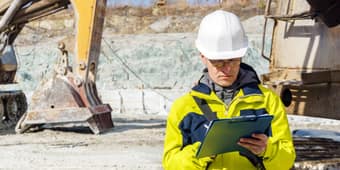More About Geotheta
Wiki Article
Little Known Questions About Geotheta.
Table of ContentsThe smart Trick of Geotheta That Nobody is DiscussingThe Main Principles Of Geotheta Facts About Geotheta RevealedHow Geotheta can Save You Time, Stress, and Money.Get This Report about Geotheta

They conduct site investigations, accumulate examples, carry out research laboratory examinations, and assess data to examine the viability of the ground for building and construction jobs - Consulting Engineer. Based on their findings, geotechnical engineers offer recommendations for foundation style, incline security, keeping frameworks, and mitigation of geotechnical risks. They collaborate with other specialists, such as architects, architectural designers, and building groups, to make certain that geotechnical considerations are incorporated into the overall job design and application
By assessing the habits and residential or commercial properties of soil and rock, they can determine potential geotechnical dangers such as landslides, dirt negotiation, or incline instability. Their competence aids avoid failings or accidents that might threaten lives and building. Here are some comprehensive tasks and obligations of a geotechnical engineer: Site Examination: Geotechnical engineers conduct site examinations to gather data on subsurface problems.
They interpret the data to understand the buildings and actions of the dirt and rock, including their stamina, permeability, compaction attributes, and groundwater conditions. Geotechnical Evaluation and Design: Geotechnical engineers evaluate the data gathered throughout website examinations to evaluate the security and viability of the website for building jobs. They perform geotechnical estimations and modeling to evaluate variables such as bearing capacity, negotiation, slope security, side earth stress, and groundwater circulation.
5 Simple Techniques For Geotheta
Structure Style: Geotechnical designers play a critical duty in making foundations that can securely sustain the designated structure. They examine the dirt conditions and load demands to establish the proper foundation kind, such as superficial structures (e.g., footings), deep structures (e.g (https://geotheta.bandcamp.com/album/geotheta)., stacks), or specialized techniques like dirt improvement. They think about factors such as negotiation limits, bearing ability, and soil-structure communication to develop optimal structure layoutsThey assess building and construction plans, screen website tasks, and conduct area assessments to verify that the layout recommendations are complied with. If unforeseen geotechnical concerns arise, they examine the scenario and give recommendations for remediation or modifications to the layout. Risk Assessment and Reduction: Geotechnical designers analyze geotechnical risks and threats connected with the task site, such as landslides, liquefaction, or soil erosion.

Cooperation and Communication: Geotechnical engineers work closely with various other experts entailed in a job, such as architects, architectural engineers, and building and construction teams. Efficient communication and partnership are necessary to incorporate geotechnical considerations right into the overall project design and building procedure. Geotechnical designers supply technological knowledge, solution inquiries, and make sure that geotechnical requirements are satisfied.
Unknown Facts About Geotheta
Below are some kinds of geotechnical engineers: Structure Engineer: Foundation designers focus on creating and analyzing structures for structures. They evaluate the dirt problems, tons needs, and website features to establish one of the most appropriate structure kind and layout, such as superficial structures, deep structures, or specialized strategies like heap foundations.They evaluate the factors affecting incline security, such as soil homes, groundwater conditions, and incline geometry, and establish strategies to avoid slope failures and mitigate risks. Earthquake Designer: Earthquake designers specialize in assessing and making frameworks to stand up to seismic pressures. They assess the seismic danger of a website, evaluate dirt liquefaction capacity, and develop seismic layout requirements to ensure the safety and durability of structures during earthquakes.
They do area screening, collect samples, and analyze the gathered information to characterize the soil homes, geologic developments, and groundwater problems at a site. Geotechnical Instrumentation Engineer: Geotechnical instrumentation engineers concentrate on surveillance and measuring the habits of dirt, rock, and structures. They install and preserve instrumentation systems that monitor factors such as soil settlement, groundwater levels, official website slope motions, and structural variations to analyze performance and offer very early cautions of potential concerns.
Some Known Factual Statements About Geotheta
They carry out tests such as triaxial tests, consolidation examinations, straight shear examinations, and leaks in the structure tests to gather data for geotechnical analysis and style. Geosynthetics Designer: Geosynthetics designers concentrate on the design and application of geosynthetic materials, such as geotextiles, geogrids, and geomembranes. They utilize these products to improve dirt security, enhance inclines, offer drainage remedies, and control erosion.They have a tendency to be investigative individuals, which suggests they're intellectual, reflective, and inquisitive. They are curious, methodical, rational, logical, and logical. Several of them are likewise social, implying they're kind, charitable, cooperative, patient, caring, valuable, understanding, tactful, and friendly. Does this seem like you? Take our complimentary profession test to discover if geotechnical designer is just one of your top career matches.
In the office setting, geotechnical engineers utilize specialized software application tools to carry out computations, create layouts, and examine data. They prepare reports, testimonial task specifications, interact with clients and team participants, and coordinate job tasks. The workplace setting gives a conducive setting for research, evaluation, and partnership with other professionals associated with the job.
Geotheta Things To Know Before You Buy
They often visit job sites to perform site examinations, analyze geotechnical problems, and gather information for evaluation. These check outs include traveling to various areas, in some cases in remote or tough terrains. Geotechnical engineers may carry out soil sampling, conduct tests, and display construction activities to make certain that the geotechnical facets of the project are being implemented properly.Geotechnical designers additionally work in specialized geotechnical research laboratories. Geotechnical research laboratory designers function thoroughly in these settings, managing screening tools, running tools, and videotaping information.
Report this wiki page